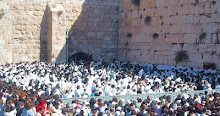First-Ever Find: Temple Menorah Relief by Jewish Eyewitness
Known depictions of the Menorah from Second Temple times include the famous relief of Titus's Arch in Rome, which shows Roman soldiers taking it away after destroying the Temple, and depictions on contemporary coins as well as graffiti etched into stone in Jerusalem's Jewish Quarter. However, the new find is said to be the first which includes a relief etched by an artist contemporary with the Temple.
The Menorah relief. (Israel Antiquities Authority, Moshe Hartal)
The synagogue has been dated to the years 50 BCE – 100 CE. The rectangular stone bearing the Menorah relief stands inside its central chamber. The chamber is about 120 square meters in size and stone benches line its sides.
The decorated stone depicts amphorae (earthenware vessels) on both sides of the Menorah and bears additional decorative motifs on its four sides and its top. %ad%
The floor of the synagogue was adorned with a mosaic and its walls were covered with a colorful fresco.
The dig was conducted by Dina Avshalom-Gorni and Arfan Najer of the Antiquities Authority. According to Gorni, the find is "unique and exciting."
Aerial view of synagogue (picture by SkyView)
"This is the first time that a Menorah decoration is discovered from the days in which the Temple still stood," she said. "It is the first Menorah that is discovered in a Jewish context, which is dated to Second Temple times – the early Roman period. We can estimate that the inscription that appears on the stone... was made by an artist who saw the seven-branched Menorah in the Temple in Jerusalem. The synagogue joins only six synagogues known in the world from Second Temple times."
The dig was conducted on land owned by a company which intends to build a hotel on the property.
Ancient Migdal – or Migdala, in Aramaic – was mentioned in Jewish sources and served as one of the central bases for forces under the command of Josephus Flavius (Yosef Ben Matityahu), who commanded the Galilee rebellion but later crossed over to the Roman camp. Resistance at Migdal continued after Tiberias and the rest of the Galilee had surrendered.
Migdal is also mentioned in the Christian "New Testament" as the place where Mary Magdalene, or Mary of Magdala, came from.
In late Second Temple times the town was an administrative center of the western Sea of Galilee area. Until the establishment of Tiberias in the year 19 CE, it was the central town on the coast of the Sea of Galilee.
The site will be open to visitors in the future.
Archaeologists find early menorah depiction
JERUSALEM – Israeli archaeologists have uncovered one of the earliest depictions of a menorah, the seven-branched candelabra that has come to symbolize Judaism, the Israel Antiquities Authority said Friday.The menorah was engraved in stone around 2,000 years ago and found in a synagogue recently discovered by the Sea of Galilee.
Pottery, coins and tools found at the site indicate the synagogue dates to the period of the second Jewish temple in Jerusalem, where the actual menorah was kept, said archaeologist Dina Avshalom-Gorni of the Israel Antiquities Authority.
The artist might have seen the menorah during a pilgrimage and then recreated it in the synagogue, she suggested.
A small number of depictions of the menorah have surfaced from the same period, she said, but this one was unique because it was inside a synagogue and far from Jerusalem, illustrating the link between Jews around Jerusalem and in the Galilee to the north.
The menorah, depicted atop a pedestal with a triangular base, is carved on a stone which was placed in the synagogue's central hall.
The temple in Jerusalem was destroyed by Roman legions in 70 A.D.. The Arch of Titus in Rome, erected to mark the Roman victory, depicts troops carrying the menorah from Jerusalem to symbolize the defeat of the Jews. The menorah became a Jewish symbol and is featured today on Israel's official emblem.
Most other depictions of the menorah were made only after the temple's destruction, and if this finding is indeed earlier it could be closer to the original, said Aren Maeir, an archaeology professor at Bar-Ilan University in Israel.
"If you have a depiction of the menorah from the time of the temple, chances are it is more accurate and portrays the actual object than portrayals from after the destruction of the temple, when it was not existent," he said.
The ancient prayer house was discovered in the town of Migdal, usually identified as the birthplace of the New Testament's Mary Magdalene, whose name is thought to be based on the town's.









No comments:
Post a Comment